
Eating disorders are serious, potentially life threatening mental disorders that affect people of all ages, genders, races, sexual orientations, and socioeconomic groups. Eating disorders are caused by a combination of biological, psychological, social, and cultural factors. Certain groups and types of people are more at risk than others for developing an eating disorder. There has been extensive research performed in the United States and Europe; however, there is a lack of research regarding eating disorders in other regions of the world. This article primarily focuses on eating disorder statistics in the United States and Europe, but it is important to note that eating disorders affect people in all countries.
Table of Contents
Overall Statistics
The statistics below apply to people in general without regards to a specific eating disorder3:
- About 30 million people in the United States are currently suffering from an eating disorder.
- Eating disorders have the highest mortality rates of any mental disorder.
- A person dies from complications of an eating disorder every 62 seconds.
- Approximately 40% of people have either suffered from an eating disorder or personally know someone who has.3

Anorexia
The Diagnostic and Statistical Manual 5 describes anorexia as a mental illness characterized by significantly low weight due to the restriction of caloric intake, an intense fear of gaining weight, a distorted perception of one’s body, and denial of the seriousness of one’s low weight. The following is a list of statistics related to anorexia in the Unitedd States and Europe:1
- About 0.9% of American women suffer from anorexia during their lifetime.
- Anorexia has the highest mortality rate of any other eating disorder.
- Approximately 1/5 anorexia deaths are due to suicide.
- Only 1/3 of people suffering from anorexia will seek treatment.
- Around 60% of the risk for anorexia is due to genetic factors.
- Anorexia is the 3rd most common chronic disease in teenageers, just after asthma and diabetes.
- People with anorexia are 10 times more likely to die than others their age.
- Approximately 25% of people with anorexia are males.
- People with type A personalities and perfectionist tendencies are more likely to develop anorexia.1
Learn more about anorexia here.
Bulimia
According to the Diagnostic and Statistical Manual 5, bulimia is an eating disorder categorized by a cycle of binge eating an abnormally large amount of food in a short period of time, followed by a compensatory behavior such as vomiting, laxative abuse, diuretics, or excessive exercise. The following statistics apply to people in the United States and Europe who are suffering from bulimia:1
- Approximately 4% of American women will suffer from bulimia during their lifetime.
- About 0.5% of males will suffer from bulimia during their lifetime.
- Half of individuals with bulimia also suffer from a mood disorder.
- Only 10% of individuals with bulimia will seek treatment.
- Bulimia has a mortality rate of about 4%.1
Learn more about bulimia here.
Binge Eating Disorder (BED)
Binge eating disorder (BED) is characterized by the DSM 5 as an addiction to food and the inability to stop eating once a healthy amount is consumed. Compared to bulimia, people with BED do not engage in compensatory behaviors after binging. The following statistics apply to individuals with BED:1
- Nearly 3% of people will suffer from BED during their lifetime.
- Half the risk for developing BED is due to genetic factors.
- Almost 50% of people suffering from BED will seek treatment.
- About 3.5% of American women suffer from BED.
- BED is more common than breast cancer, HIV, and schizophrenia combined.
- About 40% of people with BED are males.
- Approximately 30% of people seeking weight loss supplements exhibit signs of BED.
- BED most commonly begins in the late teens or early 20s.1
Learn more about binge eating disorder here.
Diabulimia
Diabulimia is characterized by the DSM 5 as someone with diabetes who manipulates their insulin intake to manage their weight. Below is a list of statistics related to diabulimia:1
- Nearly 40% of individuals with type 1 diabetes engage in behaviors consistent with diabulimia.
- Women and adolescents with diabetes are three times more likely to develop an eating disorder than those without diabetes.
- Diabulimia increases your chance of dying by 300%.1
Learn more about diabulimia here.
Avoidant Restrictive Food Intake Disorder (ARFID)
Avoidant restrictive food intake disorder (ARFID) is defined by the DSM 5 as significantly restricting one’s caloric intake, but without the body image issues or fear of weight gain that accompanies anorexia. Below are some ARFID statistics:1
- Younger males are at a higher risk of developing ARFID than older males.
- About half of the people with ARFID also have a fear of vomiting or choking.
- Approximately 20% of people with ARFID claim to avoid certain foods because of sensory problems.
- About 1/3 of children with ARFID also suffer from a mood disorder.
- Nearly 20% of children with ARFID are autistic.
- About three quarters of kids with ARFID also suffer from anxiety.1
Click here to learn more about avoidant restrictive food intake disorder.
Eating Disorder Not Otherwise Specified (EDNOS)
An eating disorder not otherwise specified (EDNOS) is an eating disorder that does not fit all the required criteria of a DSM 5 recognized eating disorder. For example, someone with EDNOS could engage in binge/purge behaviors, but engage in them less frequently than required to be diagnosed with bulimia. The following is a list of statistics associated with EDNOS:3
- Nearly half of the people with EDNOS also have a mood disorder.
- About 1/10 people with EDNOS also have a substance abuse disorder.3
Athletes
Studies have shown that athletes tend to be at a greater risk for developing certain eating disorders.2
- Over 1/3 of women in a D1 NCAA sport display attitudes that place them at risk for developing anorexia.
- About 33% of males in sports that focus on weight training like wrestling, exhibit behaviors consistent with an eating disorder.
- Approximately 40% of female high school athletes report exhibiting disordered eating behaviors.
- Athletes displaying disordered eating habits are twice as likely to incur an injury while playing their sport.
- Dancers are at highest risk of developing an eating disorder than any other sport.2
Resources
If you think you may have an eating disorder or if you do have an eating disorder there are many resources available for you. Doctors can provide a variety of resources for you such as referrals, pamphlets, books, websites, and more. Other online help centers and hotlines include:
- Eating Disorders Victoria Helpline Phone Number: 1-(300)-550-236
- ANAD Help Line Phone Number: (630)-577-1330
- ANAD Help Line Email: anadhelp@anad.org
- Support group finder: suportgroups@anad.org
- NEDA Hotline: 1-(800)-931-2237
- NEDA Crisis Text Line: text “NEDA” to 741741 to connect to a trained voluntee
Concluding Remarks
Eating disorders can affect anyone regardless of their age, race, gender, sexual orientation, or socioeconomic status. If you or someone you know is suffering from an eating disorder, it is imperative to seek treatment as soon as possible. Eating disorder can cause lifelong negative health consequences, but they are treatable if one seeks help.
References
- “Statistics & Research on Eating Disorders.” National Eating Disorders Association, 5 Apr. 2018.
- “Eating Disorder Statistics for Anorexia, Bulimia, Binge Eating.” Eating Disorder Hope.
- “Eating Disorder Statistics, National Association of Anorexia Nervosa and Associated Disorders.” National Association of Anorexia Nervosa and Associated Disorders.
Last Updated: 16 April 2018.
